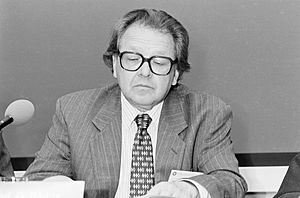George Radda facts for kids
Quick facts for kids
Sir George Radda
|
|
|---|---|

Radda in July 1996
|
|
| Born | 9 June 1936 |
| Nationality | Hungarian-British |
| Citizenship | British citizenship and Hungarian citizenship - Dual citizenship |
| Alma mater | University of Oxford |
| Known for | Molecular imaging of heart metabolism and function |
| Awards |
|
| Scientific career | |
| Institutions |
|
| Doctoral students | Stephen Busby Alister McGrath George H. Dodd |
Sir George Charles Radda (born György Károly Radda; June 9, 1936 – September 13, 2024) was an important Hungarian-British chemist. He is famous for his work using special scientific tools to study the human body. His discoveries helped doctors understand how our bodies work at a tiny level.
Sir George went to Merton College, Oxford, in 1957 to study chemistry. He was interested in how cells and their parts work. He found ways to use special lights, called fluorescent probes, to see these tiny parts.
Contents
Discovering NMR for Biology
Sir George Radda became very interested in a method called nuclear magnetic resonance (NMR). This method uses strong magnets and radio waves to create detailed pictures of what's inside things. Think of it like a super-powerful scanner.
First Steps with NMR
In 1974, Sir George published a paper that changed how scientists used NMR. He was the first to show that NMR could be used to study "tissue metabolites." These are tiny chemicals found in our body's tissues. They show how our cells are using energy and staying healthy.
NMR for Human Health
His research was so important that in 1981, he and his team showed how NMR could be used in hospitals. This led to a huge step forward in medical imaging. In 1983, a very large magnet was installed at the John Radcliffe Hospital in Oxford. This magnet was big enough to scan a whole human body! This was a big deal for understanding diseases.
Understanding Blood with NMR
In 1982, Sir George Radda also published work about how NMR could detect changes in blood. He showed how it could see "deoxygenated haemoglobin." This is a part of our red blood cells that carries oxygen. Understanding this helps doctors see how well oxygen is getting to different parts of the body.
Leading Medical Research
From 1996 until he retired in 2004, Sir George Radda was the Chief Executive of the Medical Research Council in the UK. This is a very important job. He helped decide what medical research projects the UK would support.
Awards and Honors
Sir George Radda received many special awards for his groundbreaking work. These awards showed how much his discoveries helped science and medicine.
- In 1987, he received the Buchanan Medal.
- In 1993, he was made a Commander of the British Empire (CBE).
- In 2000, he was given a knighthood, which means he became "Sir George Radda."
He was also a Fellow of Merton College, Oxford, and a Fellow of the Royal Society. Being a Fellow of the Royal Society is a huge honor for scientists in the UK. He was also an Honorary Member of the American Heart Association. This shows his work was recognized worldwide.
In 2015, he was made an Honorary Citizen of Singapore. This was a special award for his contributions there.

